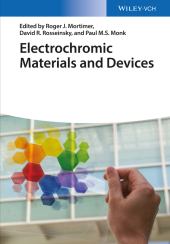 Neuerscheinungen 2015Stand: 2020-02-01 |
Schnellsuche
ISBN/Stichwort/Autor
|
Herderstra▀e 10
10625 Berlin
Tel.: 030 315 714 16
Fax 030 315 714 14
info@buchspektrum.de |

Paul M. S. Monk, Roger J. Mortimer, David R. Rosseinsky
(Beteiligte)
Electrochromic Materials and Devices
Ed. by Roger J. Mortimer, David R. Rosseinsky and Paul M. S. Monk
1. Auflage. 2015. XXVIII, 638 S. 120 SW-Abb., 80 Farbabb. 24,5 cm
Verlag/Jahr: WILEY-VCH 2015
ISBN: 3-527-33610-9 (3527336109)
Neue ISBN: 978-3-527-33610-4 (9783527336104)
Preis und Lieferzeit: Bitte klicken
Electrochromics change their color when an electric field is applied. The basic principles, materials classes and devices are explained by expert researchers with an emphasis on current and future applications.
PART ONE
ELECTROCHROMIC MATERIALS AND PROCESSING
Electrochromic Materials and Devices: Introduction and Historical Perspective
Electrochromic Metal Oxides: An Introduction to Devices and Materials
Tungsten Oxide: Thin-Film Deposition Techniques and Spectroscopic Properties
Electrochromic Materials and Devices based on Prussian blue and other Metal Hexacyanometallates
Electrochromic Viologens: Devices and Materials
Electrochromic Devices based on Prussian Blue/Viologen Electrochromic Materials
Electrochromic Conjugated Conducting Polymers: Materials, Colour Control and Devices
Electrochromic Conjugated Conducting Polymers: Solution-Processable Polymers
Electrochromism within Transition Metal Coordination Complexes and Polymers
Near-infrared Electrochromic Materials based on Transition Metal Coordination Complexes
PART TWO
NANOSTRUCTURED ELECTROCHROMIC MATERIALS
Nanostructures in Electrochromic Materials and Devices
Nanotubes as Templates for the Fabrication of Fast-switching Electrochromic Materials
Layer-by-layer Assembly of Electrochromic Materials
PART THREE
APPLICATIONS OF ELECTROCHROMIC MATERIALS
Solution-phase Electrochromic Devices for Automotive Mirror and Smart Window Applications
Electrochromic Smart Windows for Dynamic Daylight and Solar Energy Control in Buildings
Fabric Electrochromic Displays for Adaptive Camouflage, Biomimicry, Wearable Displays and Fashion
PART FOUR
DEVICE CASE STUDIES AND ENVIRONMENTAL IMPACT ISSUES
Case Study I: ChromoGenics┤ ConverLight Electrochromic Foil
Case Study II: Gesimat┤s Electrochromic Glass Laminates
Life Cycle Analysis (LCA) of Electrochromic Smart Windows
Electrochromic materials can change their optical properties on the application of an electrical voltage or current. Different classes of materials show this behaviour including transition metal oxides, conjugated polymers, metal-coordinated complexes and organic molecules. As the colour change is persistent, the electric field usually needs only to be applied to effect the switching, allowing for applications such as low energy-consumption displays, light-adapting mirrors in vehicles, and ┤smart windows┤ for which the amount of transmitted light and heat can be controlled.
The first part of this book describes the different classes and processing techniques of electrochromic materials. The second part highlights nanostructured electrochromic materials and device fabrication, and the third part focuses on the applications such as smart windows, adaptive camouflage, wearable displays and fashion. The last part of the book comprises case studies and environmental impact issues.
From the contents:
Part One: Electrochromic Materials and Processing
Part Two: Nanostructured Electrochromic Materials and Device Fabrication
Part Three: Applications of Electrochromic Materials
Part Four: Device Case Studies, Environmental Impact Issues and Elaborations


